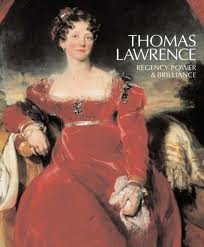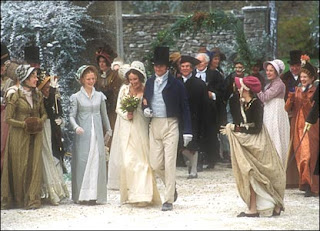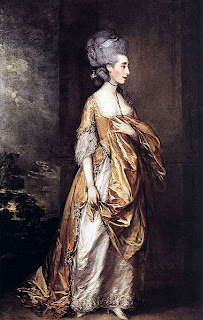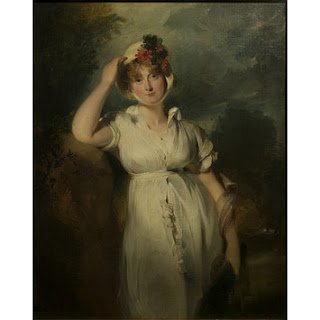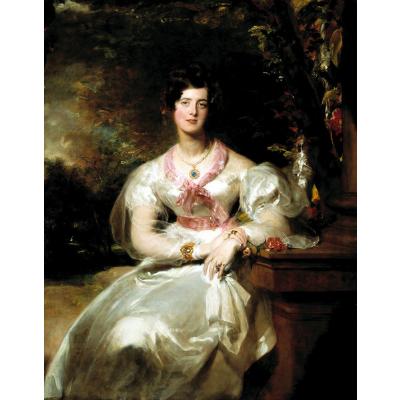Knebworth House in Hertfordshire, just north of London, was the home of Edward Bulwer-Lytton (1803-1873), politician, statesman, and author of dozens of novels. Our tastes in literature have left poor B-L far, far behind. But his house is often a star in its own right, currently as the home of Logan Mountstuart’s wife, Lottie (Lady Laeticia) and her father, the earl of Edgefield, in the series Any Human Heart on PBS’s Masterpiece.

Any Human Heart is based onWilliam Boyd’s 2002 novel, subtitled The Intimate Journals of Logan Mountstuart. The story goes from Logan’s coming of age through his lifetime. Though the novel is said to be a literary attempt to put political and social events into a personal context, the television version seems more to be an amazingly frequent set of encounters with famous persons, such as Miro, Hemingway, Wallis Simpson, James Joyce, et. al., while Logan has a series of life crises in which he usually turns out to be a cad.
But the point of this post is the house, Knebworth, playing the role of fictional Thorpe Hall. Knebworth has been in many films and tv shows, including The King’s Speech, and Batman, where it purports to be David Wayne’s elegant manor. Kristine and Victoria, with a group of their friends, visited Knebworth on cloudy day a few years ago. The grey skies seemed a perfect background for the ornately gothic pile of yellowish sandstone. Take a look at the Knebworth website here.

A mere thirty miles north of London, Knebworth House raises its ornate turrets, decorative crenellated chimneys and fanciful columns topped with heraldic beasts to the Hertfortshire sky. The Lytton family has occupied the property for more than 500 years.
Although every stately home in England has a fascinating history peopled with interesting inhabitants, Knebworth is particularly well endowed with eccentric, even tragic, characters. The medieval era house, with assorted changes, stood until the early 19th century. Freed from an unhappy marriage by the death of her husband, the redoubtable heiress, Elizabeth Lytton (1773-1843), made the first of extensive architectural changes in the early 19th century .
.
She and General William Bulwer (1757-1807), had several children, the youngest of whom became Sir Edward Bulwer-Lytton, (1803-1873), probably the most famous family member, immortalized by Snoopy’s efforts to begin his novel, “It was a dark and stormy night.”
Elizabeth had three sides of the sprawling old structure demolished. The remaining side, preserving the ancient Banqueting Hall with its carved screen, was remodeled in the fashionable gothic style, with a medieval style towers and battlements.
Bulwer-Lytton, a budding poet, had a love affair with Lady Caroline Lamb (known particularly for her pursuit of Lord Byron, the poet) in the 1820’s. A copy of her notorious novel Glenarvon (1816) is on display at Knebworth inscribed by Bulwer-Lytton: “Poor Lady Caroline . . . she could not but inspire deep pity that was heightened by admirations for talents and qualities that well trained, might have made her one of the first women of her time.”
Soon after the affair concluded and against the wishes of his mother, Bulwer-Lytton married Rosina Doyle Wheeler in 1827, one of the most disastrous mismatches of the era. Always short of funds, nevertheless they lived extravagantly. Their two children, a daughter, Emily, and a son, Teddy (later first Earl of Lytton), both suffered from the constant battles between their parents.
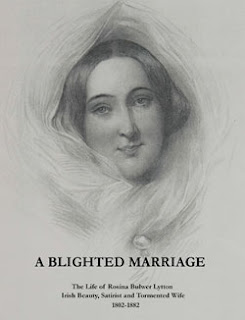 At times Rosina was banished from her husband’s presence. Once, after she interrupted a political campaign meeting to denounce him, she was placed in a mental institution until public outrage brought her release. Rosina published thirteen novels and many other works on women’s issues. Quoting the guidebook to the house (p. 11), “Ostracised (sic) by the family for a century, Rosina has now been readopted. Her contribution to the struggle for women’s rights has been recognized . . . and the present Lord Cobbold (David Lytton Cobbald) named his daughter after her.”
At times Rosina was banished from her husband’s presence. Once, after she interrupted a political campaign meeting to denounce him, she was placed in a mental institution until public outrage brought her release. Rosina published thirteen novels and many other works on women’s issues. Quoting the guidebook to the house (p. 11), “Ostracised (sic) by the family for a century, Rosina has now been readopted. Her contribution to the struggle for women’s rights has been recognized . . . and the present Lord Cobbold (David Lytton Cobbald) named his daughter after her.”

Bulwer-Lytton, a member of parliament, a journalist and playwright, as well as th
e author of seventy novels, did not live at Knebworth until after his mother’s death in 1843. When he took over the estate, he began further changes to enhance Gothic elements of the house. Separated permanently from Rosina, he entertained frequently, often staging amateur and professional theatricals with his friend and fellow writer, Charles Dickens. In the sober library of the house, some of Bulwer-Lytton’s novels are on display, the most famous of which is probably Last Days of Pompeii (1834).

Additional changes to the house were made by his grandson, Victor, second earl of Lytton, with the help of his brother-in- law, the renowned architect Sir Edwin Lutyens. In addition to the fine ancient banqueting hall, today’s visitors will enjoy the army’s many suits of armor, the High Gothic State Drawing Room, and
Elizabeth’s regency-era bedroom, preserved as it was in her day at the request of her son. All the afore-mentioned persons are pictured in the extensive family portrait collection. The house gave me a rather melancholy impression, only partially offset by the handsome Knebworth gardens. Below are views of Knebworth, inside and out.
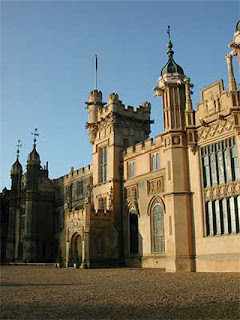 |
| Entrance Hall
The Amoury
Two pictures above, the adventure playground woods |
Like so many stately homes in Britain, Knebworth House must pay its own way, and thus is not only a fascinating historical site and a rich source of settings for films. There are a variety of attractions for children, frequent corporate events and weddings, charity fetes and shows is all kinds (antiques, cars etc etec.) and many, many concerts, mostly rock music, with audiences upwards of 50,000. Dark and stormy it was not!
